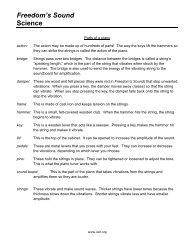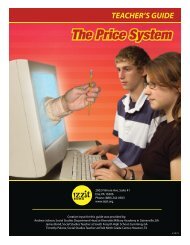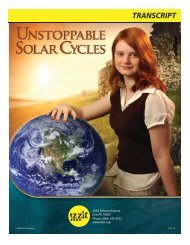Transcript - Izzit.org
Transcript - Izzit.org
Transcript - Izzit.org
You also want an ePaper? Increase the reach of your titles
YUMPU automatically turns print PDFs into web optimized ePapers that Google loves.
put together with one purpose in mind. And that purpose is: To reduce the amount of human muscle<br />
needed to do any particular job. The next step was to eliminate it altogether by using animal muscle.<br />
WOMAN: One horse or one ox has the strength of twenty men. It can do twenty times more work and<br />
create twenty times more surplus. But it’s possible in the end to do away with all muscle power<br />
altogether – animal or human.<br />
MAN: And that’s by harnessing the forces of nature. Water power can grind corn…<br />
WOMAN: …it can also power spindles and looms.<br />
MAN: But there are more powerful and more useful sources of energy in nature…<br />
WOMAN: …the wind…<br />
MAN: …coal…<br />
WOMAN: …oil…<br />
MAN: …uranium.<br />
WOMAN: It isn’t all that long since we were using simple machines combined with animal power to<br />
produce surpluses.<br />
MAN: Even today in some parts of the world animal muscle is still the main source of surplus. There are<br />
places where animals are still used for freight, or carrying passengers…or for machine power.<br />
WOMAN: Until the railways in the 1830s- a horse was still the fastest means of travel on the land, just<br />
as it had been for tens of thousands of years. But in time, the way the machines were applied became<br />
more complicated; but no matter how sophisticated they got, they were still a combination of very simple<br />
machines.<br />
MAN: The wheels and axles on this modern tractor enable it to tackle ground farmers would once never<br />
have dreamed could produce any crops. And the gears that make it possible to go up and down steep<br />
slopes are operated by levers.<br />
WOMAN: Basic machines- combined together make it possible for us to turn nature’s energy into huge<br />
surpluses. But it’s only possible to produce surpluses like these- when you can draw the energy you need<br />
from one of nature’s great resources.<br />
MAN: Until the end of the nineteenth century wind powered the fastest method of travel over water. But<br />
there was something much more effective than either wind or water. That was the power of fire.<br />
WOMAN: Fire transformed the world. First it boiled water for steam engines…then it ignited petrol in<br />
combustion engines and generated power for steam turbines.<br />
MAN: And more recently the controlled energy from nuclear reactors has been converted to electrical<br />
energy. And what does it add up to – all this application of different forms of energy<br />
18

















